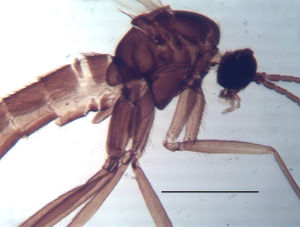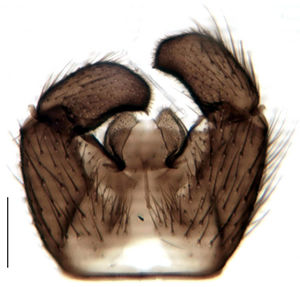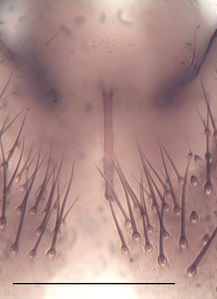Trichosiopsis subviatica heikendorfensis
Ordo: Diptera
Familia: Sciaridae
Genus: Trichosiopsis
Species: Trichosiopsis subviatica
Name
Trichosiopsis subviatica heikendorfensis unpublished
Type material
Holotype: ♂, 19.05.2013, Sweep netting, leg. Heller, ZFMK-TIS-2513624 in ZFMK
Type locality
Germany, Schleswig-Holstein, Heikendorf, Korügen
Barcoded material
| Stadium | Country | Province | Locality | Habitat | Method | Date | Collector | Collection Number | Collection | Latitude | Longitude | Elevation (m) |
|---|---|---|---|---|---|---|---|---|---|---|---|---|
| 1 ♂ (holotype) | Germany | Schleswig-Holstein | Heikendorf, Korügen | Buchenwald | Sweep netting | 19.05.2013 | Kai Heller | ZFMK-TIS-2513624 | ZFMK | 54.384 | 10.208 | 15 |
| 1 | Germany | Baden-Württemberg | Tübingen, Wiesenweingaerten | Malaise Trap | 23.5.–6.6.2014 | T. Kothe, M. Engelhardt & Ch. Koenig | BIOUG26225-C07 | ZFMK | 48.504 | 8.996 | 382 | |
| 1 ♂ | Germany | Rhineland-Palatinate | Heppingen-Gimmingen, Landskrone | Schotterhalde bei Kapelle | Malaise Trap | 9.4.–24.4.2014 | Rulik et al. | ZFMK-TIS-2564683 | ZFMK | 50.551 | 7.171 | 233 |
| 1 ♂ | Germany | Rhineland-Palatinate | Niederzissen, Bausenberg | Wiese | Malaise Trap | 16.5.–2.6.2014 | Rulik et al. | ZFMK-TIS-2559684 | ZFMK | 50.465 | 7.226 | 292 |
Other material studied
France: 1 ♂, Marais de Lavours, prairie, Malaise trap, Withers, 21.-30.06.2009, PKHH 7979; Germany: 1 ♂, Schleswig-Holstein, Flensburg, Marienhölzung, forest, Malaise trap, Barkemeyer, 17.-24.05.1996, PKHH 2054; 1 ♂, Heikendorf, garden, Malaise trap, Heller, 19.-27.04.1997, PKHH 2330; 1 ♂, 22.-28.06.1997, PKHH 2460; 1 ♂, 10.05.1991, PKHH 21; 1 ♂, Kiel University, garden, Malaise trap, Heller, 5.-12.05.1995, PKHH 1015; 2 ♂, Wankendorf, old beech stump, photoeclector, Warning, 22.5.-05.06.1989, PKHH 8/9.
Description (male)
Head. Eye bridge 5 rows of facets. Antenna unicolour. LW-index of 4th flagellomere 2.3–2.6; neck 0.32–0.45 × segment width; transition of basal part to neck pronounced. Colour of neck unicolour. Antennal setae shorter than segment width; of normal strength; dense; salient. Palpus darkened; of normal length; palpomeres 3. First palpomere of normal shape, or thickened; with 6–8 setae; with only sparse sensilla. Second palpomere short and oval. Third palpomere as long as first. Thorax. Colour dark brown, or brown. Notum unicolour. Thoracic setae long and strong; black. Posterior pronotum bare. Mesothoracic sclerites bare. Legs. Colour yellow-brown. Hind coxa darkened. Setae on front coxa black. Front tibial organ as patch of setae; dark; front tibial organ not bordered. Tibial setae on hind legs weak and inconspicuous. Tibial spurs of equal length. Claws untoothed. Wing. Wing slightly darkened; of normal shape. Wing membrane without macrotrichia. Wing venation weak, with faint stM. M-fork of normal shape. R1 ending at or slightly before base of m-fork; posterior veins with macrotrichia; stM mostly with macrotrichia; CuA1 and CuA2 mostly with macrotrichia; bM bare; r-m with few setae, or mostly setose; bM:r-M 0.9–1.1; st-Cu:bM 0.2–0.4; R1:R 1.6–1.85; c:w 0.66–0.76. Halter darkened; of normal length. Abdomen. Abdominal setae strong; dense; on tergites black; on sternites black. Hypopygium concolour with abdomen; LW-index 0.64–0.8. Base of gonocoxites with strong setae; gonocoxites broadly separated; inner margin of gonocoxites typically U-shaped; inner membrane of hypopygium scarcely setose; ventral margin of gonocoxite with short setae. Gonostylus elongate; LW-index 2.1–2.3; Inner margin concave; apex equally rounded, or with one obtuse angle. Apical tooth present; without internal structure; of medium strength; LW-Index 1.7–2.7. Awl-like setae normal; present beneath apical tooth. Megasetae absent. Whiplash-hair absent. Tegmen 0.5–0.7 × longer than broad; rectangular with rounded edges; without special features; central process absent. Length of ejaculatory apodeme/hypopygium 30–45 %; base of ejaculatory apodeme present. Field with aedeagal teeth inconspicuous. Measurements. Body size 4–4.5 mm. Hind tibia 1.9–2.15 mm. Wing length 3.2–4 mm.
Diagnosis
Trichosiopsis subviatica heikendorfensis is very large and characterized by a gonostylus, which is bi-angulate in most cases. The posterior pronotum is bare and the legs are darkened.
DNA Barcoding
The COI sequence is assigned to one part of BIN BOLD:ACK0022 (average distance 0.84%, max. 1.34%, n=4).
Etymology
The species is named after the village Heikendorf, where the species was collected for the first time.
Discussion
This is the largest subspecies and genetically apparently more heterogeneous than the other ones.
Distribution
France, Germany.
Images
|





